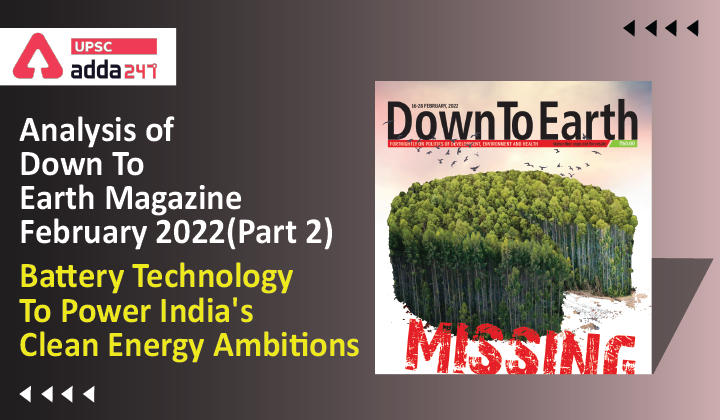Table of Contents
Analysis of Down To Earth Magazine: Battery Technology To Power India’s Clean Energy Ambitions
Relevance
”GS 3: Growth & Development, Government Policies & Interventions”
Introduction
Technologically sound Batteries(with greater storage capacity) can play a crucial role in helping India achieve its target of having 450 gigawatts of renewable energy from solar and wind by 2030.
Types of Batteries
- Currently across the world, four types of batteries are in use: lead-acid, lithium-ion (including variants), nickel-metal hydride and vanadium ion batteries.
- While lead-acid and lithium-ion batteries are the only two currently available in the Indian market, several other technologies like vanadium redox, metal-air, metal-ion and liquid metal batteries are also being explored for application across sectors.


Lead-Acid Batteries harms the Environment
- Lead-acid batteries have been in use for long, and continue to be an economical option with supply chains already in place.
- However, they pose a potential threat to health and the environment if improperly discarded.
- According to the World Health Organization, lead is a naturally toxic metal, which if ingested or in- haled in large quantities can cause anaemia, brain and organ damage and even death.
- The UN Environment Programme, lead is also a pollutant, and improper disposal or recycling of batteries can dispel toxic fumes in the air, soil and water.
Qualities of Lithium-ion batteries
- It is considered a cleaner option when compared with lead-acid batteries.
- Lithium-ion batteries have a density of 100-265 Wh per kg.
- This ability to achieve higher energy densities allows its use in smaller batteries, making it attractive for electric vehicles.
- This is why the global battery market has been dominated by lithium-ion batteries.
- The Centre in 2021 approved Rs 18,100 crore Production Linked Incentive Scheme for manufacturing, export and storage of lithium-ion cells.
Limitations of lithium-ion battery
- The lithium-ion battery also has limitations. It is expensive, with reserves localised only in certain parts of Chile, Australia, Argentina and China.
- It has some environmental costs by way of mining.
- Also, these batteries run the risk of exploding if they overheat.
- China controls 80 per cent of the world’s lithium refining and 77 per cent of the world’s cell capacity.
Sodium Batteries
- Sodium-ion batteries have three essential components: a negatively charged anode made up of hard carbons; a positively charged cathode constituting sodium-containing layered materials; and an electrolyte that allows electrons to move.
- They work in a similar manner to lithium batteries.
- When the batteries are in a charging state, sodium atoms in the cathode become ions by releasing electrons.
- These ions flow through the electrolyte while the electrons move through an external circuit to reach the anode.
- During the discharge state, the reverse happens—from anode to the cathode.
Factors that influence the growing favourability of sodium over lithium
- The element is abundant in nature—the Earth’s crust has 2.9 per cent of the element while lithium’s share is only 0.01 per cent.
- Sodium can be found naturally in seawater and also mined from soda ash.
- The cost of extracting sodium is at least 20 per cent lower than lithium.
- Sodium is also relatively safer than lithium.
Limitations of sodium batteries
- Like lithium, sodium-ion batteries also use organic electrolytes that are flammable.
- It is possible to make the batteries safe by modifying their chemistry.
- Sodium also falls short in terms of energy density, thus making it difficult to make small batteries for use in electric vehicles.
Way Forward
- Now our focus should be on exploring batteries’ potential for stationary energy storage.
- An element like vanadium will help here. Vanadium outperforms lithium in safety and scalability and can last for 15-20 years as against the latter’s lifespan of four-five years.
- It is naturally present in 65 different minerals and makes up over 20-megawatt hours of installed storage capacity globally.
- Any new battery technology for storage, when introduced, will need to be evaluated in the real world.
Conclusion
India should strengthen its battery ecosystem by forging ties between scientists and industry and raising funding. The focus should also be on building a robust recycling system. The country can fulfil one-third of its future battery needs by recycling discarded lithium-based gadgets.



 TSPSC Group 1 Question Paper 2024, Downl...
TSPSC Group 1 Question Paper 2024, Downl...
 TSPSC Group 1 Answer key 2024 Out, Downl...
TSPSC Group 1 Answer key 2024 Out, Downl...
 UPSC Prelims 2024 Question Paper, Downlo...
UPSC Prelims 2024 Question Paper, Downlo...




